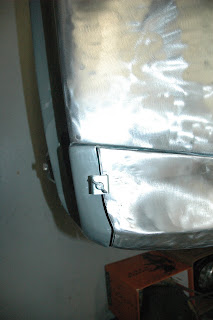
I also used a combination of wire brush and Zinc rust condition on the stringer that the nose piece mounts on, followed by a few coats of Wurth self etching primer.

The front has been banged up pretty good over the life of the car so I spent lots of time dollying and bumping the area around the bumper mounts, as well as on the bumper mounts themselves. This is crucial to ensure that the nose panel has proper orientation to the rest of the car. Combined with the stringer between the fenders, they're the only reference I have for getting it straight.
With a spirit level, masking tape, and a measuring tape I spent a good amount of time trying to get everything as straight as possible. There's some damage to the passenger side bumper mount which made it tricky, but I managed to get it within about a sixteenth of an inch of the driver's side mount.
I also ground off old welding material and removed rust from the cross member which the lower part of the nose piece is welded. With that in place I could again fit the nose and start working on that repair panel.

As you can see, the bumper is temporarily mounted in order to make sure that the fenders and nose piece are properly oriented. Assuming that everything will lined up and painting the car is not the right way to approach this. Essentially every component that attaches to the body must be trial fit several times before the car ever gets painted in order to ensure it will be right when the time comes for final assembly.
Here's another picture of the repair panel temporarily in place, during one of the 25 or so times I installed and removed it before taking another 32nd of an inch off the surrounding metal to get the fit right.

As you can see, the crease along the top of the fender as long as the waistline crease are still not lined up properly, so I've still got more work to do.
On another topic, Chel and I finally got around to measuring the valve clearances this afternoon. I was not surprised to find that nearly all of the shims that came with the head were not at all close to the right size. The head has a fresh valve job and the only shims I had were from before that happened, so as you'd expect, the clearances were all way off. At least I have a reference point now, and I know what size shims I need to get to set them properly. On a disappointing note, I could not get one of the studs that holds the rear camshaft cap on the intake size to torque down. The stud is pulling up through the head. I will have to take the head back to my machinist and see if he can install a timesert of do something to prevent it from pulling out. They're only torqued to 15 foot pounds but they need to hold that much torque.
I'm expecting at least 5 or 10 more hours of work trimming and fitting the metal on the nose before I can get serious about welding it, but hopefully I'm getting closer.









